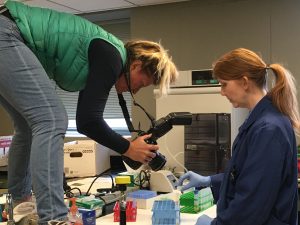Behind-the-scenes access is a definite perk to writing environmental nonfiction. Zoo Scientists to the Rescue uses the work of three zoo scientists to tell the stories of how zoos are helping three endangered species. In the above Annie Crawley video, Rachel Santymire (aka Dr. Poop) extracts rhino hormones from feces. Read the book to find out the whole story.
Catch up with Rachel in this short Q&A for more behind-the-scenes info
Patricia: Your official title at the Lincoln Park Zoo is the Director of the Davee Center for Epidemiology and Endocrinology. What does the job entail?
Rachel: I have the privilege to drive a lot of the science that happens in the Davee Center and collaborate with others in the zoo’s Conservation and Science Department and at many of the local universities. I also oversee the Davee Center staff members and their research. We discuss project ideas and what directions we want to take our center. For example, Dr. Maureen Murray, the newest member of the Davee Center, is our wildlife disease ecologist. Maureen is developing projects to study wildlife health and how urbanization affects wildlife disease risks in Chicago. Matt Mulligan is our field scientist and has developed projects to study smaller urban animals like bats and rodents. Both Lisa Raimondi and Katie Fowler keep the endocrinology lab functioning and help not only with sample analysis but also develop new techniques to measure hormones in different biomaterials like horse and black rhino hooves. To support these projects, I write several grants a year. And with every successful project, we publish our results in scientific, peer-reviewed journals. Answering questions about wildlife to conserve them in the wild and at the zoo is very rewarding. Everyone in the Davee Center is passionate about what they do!
Patricia: What other species besides black rhinos do you work with at the zoo? Can you share some of your behind-the-scenes successes?
Rachel: In my endocrinology laboratory at the zoo, we have studied the hormones of nearly 100 species, from large mammals like African lions to very small ones like gerbils from Israel. Besides mammals we have measured the hormones of reptiles like the eastern massasauga rattlesnake, birds like the Puerto Rican parrot, and 20 species of amphibians. My motto used to be, “if it poops, we study it.” But now we use some many different types of samples like keratin from hooves, feathers, saliva and urine to study animals’ hormones. Our most exciting new method—skin swabbing— was developed for amphibians, since they are “elusive poopers”! We have a new publication in the Journal of Conservation Physiology that details how you can measure stress hormones in amphibians by simply swabbing their skin. No longer will researchers have to collect blood or hold frogs in water to measure cortisol. This changes the field especially when studying wild amphibians!
Are you craving more info about black rhinos? Try these links:
- Black rhino fact sheet
- Black rhino conservation in Addo Elephant National Park
- Download the following resources from my website:
- our #ProtectOurWorld Challenge Poster
- Listen to the first chapter of Zoo Scientists to the Rescue on TeachingBooks.net
- Pinterest activities
- Teacher Guide
Use zoo science at home too!
Zoo scientists work hard to understand animal behavior so they can keep the animals active and engaged. Test drive some favorite zoo enrichment activities on your dog: Learning from Zoos: 11 Brilliant Mental Exercises for Your Dog.







Leave a Reply
Your email is safe with me.